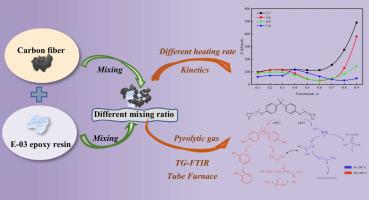Journal of Analytical and Applied Pyrolysis ( IF 5.8 ) Pub Date : 2023-02-11 , DOI: 10.1016/j.jaap.2023.105919 Lichao Ge , Xi Li , Hongcui Feng , Chunyao Xu , Yanning Lu , Bo Chen , Dongyang Li , Chang Xu

|
In the future, wind turbine blade waste will increase significantly. However, there is no proper treatment plan for this condition. Pyrolysis is one of the most feasible methods for recycling waste wind turbine blades. In this paper, the thermal degradation behaviors of epoxy resin mixed with carbon fiber applied in wind turbine blade base components were studied by thermogravimetric analysis, thermogravimetric-Fourier transform infrared spectroscopy and tube furnace. The effects of different heating rates and mixing ratios were investigated, the kinetics of the pyrolysis reaction were calculated in detail, and the composition of the pyrolysis volatile fraction was studied. The results showed that increasing the heating rate was more favorable for the pyrolysis characteristics of mixed samples. However, it would reduce the degree of pyrolysis, showing a different pattern from that of the pure epoxy resin. The activation energy of pyrolysis was calculated by the Coats and Redfern method and Flynn–Wall–Ozawa method, and the effects of the mixing ratio on the activation energies of the samples were greater than those of the heating rate. During the thermal decomposition of the sample, mainly carbon–oxygen compounds, methane, alkanes, olefins, carboxylic acids and aromatic compounds were produced. The pyrolysis of the mixture could be divided into three steps based on the product characteristics combined with kinetic calculation results. According to the tube furnace results, the best calorific value and recovery value of gaseous products are obtained with the sample proportion closest to the actual component. In general, the copyrolysis of carbon fiber and epoxy resin is much more complicated than that of epoxy resin alone, and the addition of carbon fiber eases the epoxy resin pyrolysis process, which does not exclude the existence of synergistic effects in the pyrolysis process; additionally, the difference in pyrolysis behavior is greater under different mixing ratios. Based on this phenomenon, basic data support was provided for further research on the pyrolysis and recycling process of waste wind turbine blades.
中文翻译:

废旧风力发电机叶片基础组分(环氧树脂和碳纤维)的热解过程、动力学和产物分析
未来风电叶片废料将大幅增加。但是,这种情况没有适当的治疗计划。热解是回收废弃风力涡轮机叶片最可行的方法之一。本文采用热重分析、热重-傅立叶变换红外光谱和管式炉研究了应用于风力涡轮机叶片基体部件的碳纤维混合环氧树脂的热降解行为。研究了不同升温速率和混合比的影响,详细计算了热解反应的动力学,研究了热解挥发分的组成。结果表明,提高升温速率更有利于混合样品的热解特性。但是,它会降低热解程度,显示出与纯环氧树脂不同的图案。热解活化能采用Coats and Redfern法和Flynn-Wall-Ozawa法计算,混合比对样品活化能的影响大于升温速率。样品在热分解过程中,主要产生碳氧化合物、甲烷、烷烃、烯烃、羧酸和芳香族化合物。根据产物特性结合动力学计算结果可将混合物的热解分为三个步骤。根据管式炉结果,以最接近实际组分的样品比例获得气态产物的最佳热值和回收值。一般来说,碳纤维与环氧树脂的共热解比单独的环氧树脂复杂得多,碳纤维的加入缓和了环氧树脂的热解过程,不排除在热解过程中存在协同效应;此外,不同混合比下的热解行为差异更大。基于这一现象,为进一步研究废弃风力机叶片的热解回收工艺提供了基础数据支持。

































 京公网安备 11010802027423号
京公网安备 11010802027423号